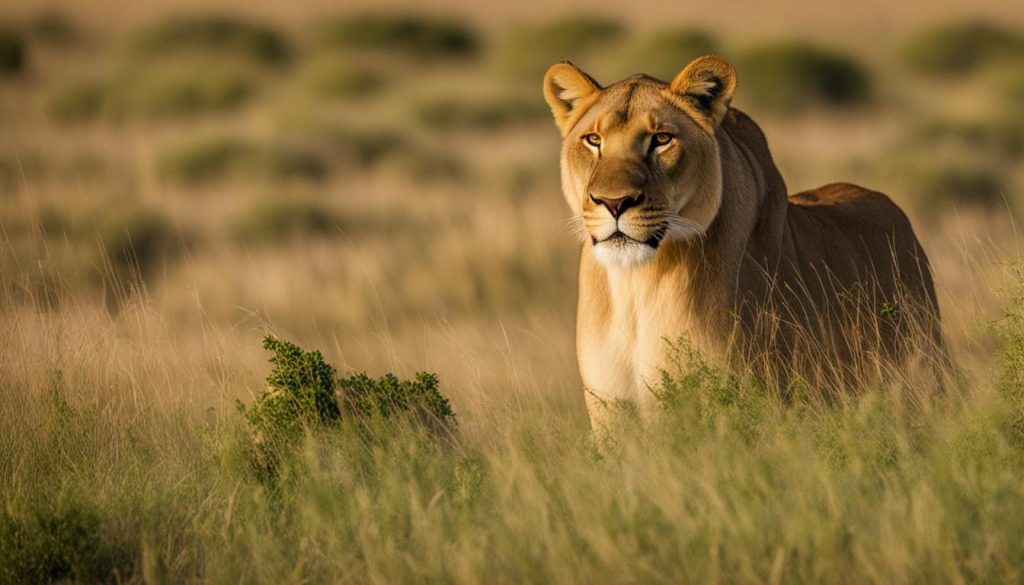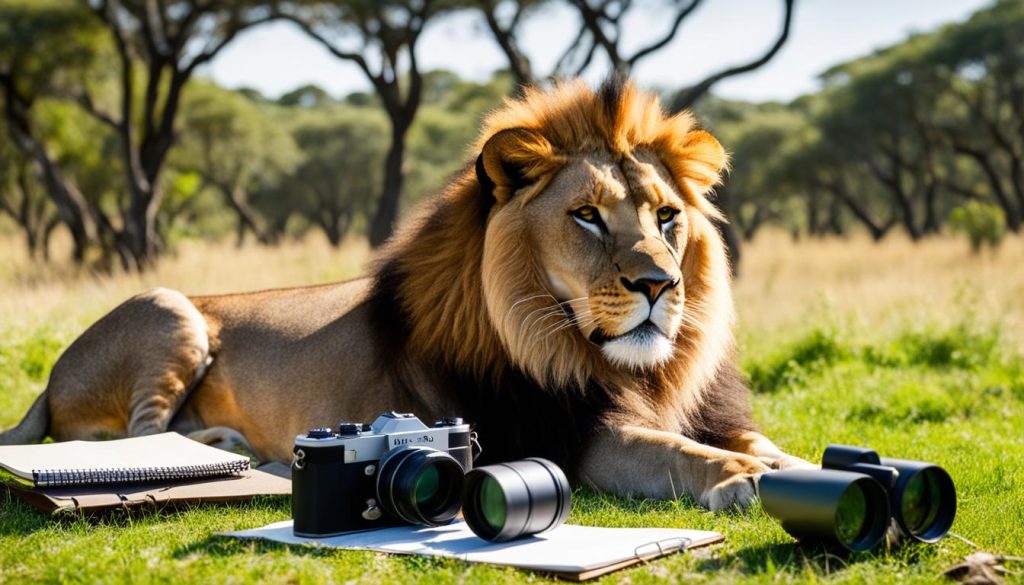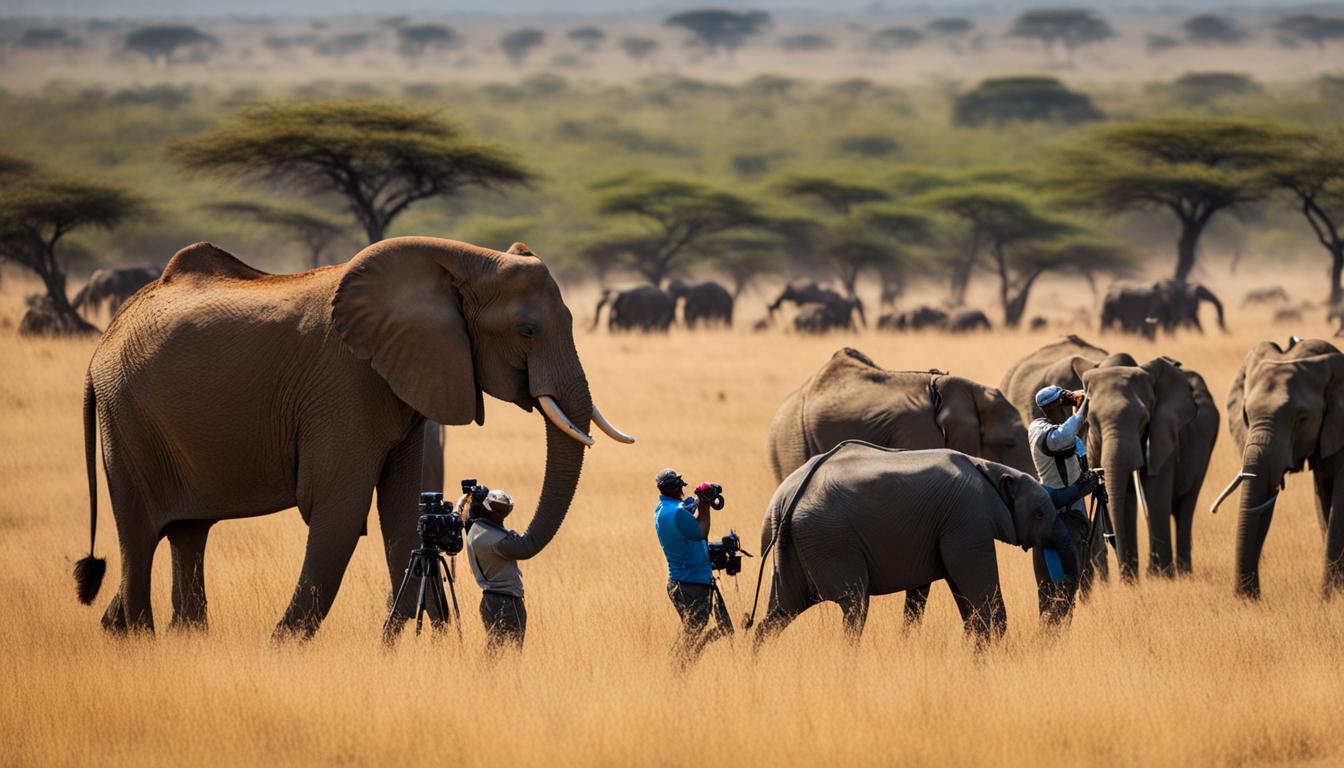Welcome to the captivating world of safari photography! Nothing compares to the thrill of venturing into the wild and capturing breathtaking images of wildlife in their natural habitats. Whether you’re planning an African safari or exploring other wildlife-rich areas, mastering the art of safari photography will allow you to document the wonders of the animal kingdom and create lasting memories.
In this article, we’ll guide you through some essential tips and techniques that will help you elevate your wildlife photography skills. From choosing the right safari location to understanding camera settings and techniques, we’ve got all the information you need to embark on your own safari photography adventure.
Key Takeaways:
- Explore the possibilities of safari photography to capture stunning images of wildlife in their natural habitats
- Choosing the right safari location is crucial for maximizing wildlife sightings and photographic opportunities
- Invest in appropriate equipment and familiarize yourself with essential camera settings and techniques
- Understanding animal behavior and practicing patience are key to capturing unique and impactful wildlife shots
- Respect the animals’ space and refrain from interfering with their natural behavior
Deciding Your Safari Location
One of the first steps in planning your safari photography adventure is deciding on the location. While African safaris are widely recognized and offer incredible wildlife sightings, there are many other places around the world where you can experience a safari.
Take into consideration the wildlife you want to capture, the best time of year for sightings, and the accessibility of the locations you’re considering. Factors such as weather, wildlife migration, and park regulations should also be taken into account when deciding on your safari location.
Choosing the Right African Safari Experience
If you’re looking to immerse yourself in the heart of Africa’s diverse wildlife, an African safari is a top choice. With iconic destinations such as Kenya’s Maasai Mara National Reserve, Tanzania’s Serengeti National Park, and South Africa’s Kruger National Park, you’ll have plenty of opportunities to witness the “Big Five” – lions, elephants, buffalos, leopards, and rhinos – in their natural habitats.
Exploring Wildlife Safari Destinations Worldwide
However, if you’re seeking a unique safari experience beyond Africa, there are other remarkable destinations to consider. The Galapagos Islands in Ecuador offer an extraordinary opportunity to observe diverse wildlife species found nowhere else on Earth. In South America, the Pantanal wetlands in Brazil teem with an incredible abundance of wildlife, including jaguars, giant otters, and capybaras. Across Asia, the jungles of Borneo and the national parks of India provide thrilling encounters with orangutans, tigers, and rare bird species.
Remember, the key is to choose a safari location that aligns with your wildlife photography goals and interests.
Research and Expert Advice
Before making a final decision, thoroughly research each safari location you’re considering and consult with travel experts or experienced photographers who have visited those destinations. They can provide valuable insights and recommendations based on their firsthand experiences.
By carefully selecting your safari location, you can ensure an unforgettable wildlife photography experience with incredible sightings and remarkable photographic opportunities.
Choosing the Right Equipment
When it comes to capturing stunning wildlife images on safari, having the right equipment is essential. Investing in the right gear will enable you to capture every detail and moment of your safari experience. Here are some key elements to consider when selecting your safari photography equipment:
- Camera: Opt for a DSLR or mirrorless camera with manual control and weather sealing. These cameras offer the versatility and durability needed to withstand the unpredictable conditions of wildlife photography.
- Telephoto Lens: A quality telephoto lens is a must-have for safari photography. It allows you to get up close to wildlife, capturing their intricate features and behaviors. Look for a lens with a long focal length, such as 200mm or more, for optimal results.
- Wide-Angle Lens: In addition to a telephoto lens, consider bringing a wide-angle lens to capture animals in their natural environments. Wide-angle shots can provide a sense of scale and context, showing the wildlife in relation to their surroundings.
- Accessories: Don’t forget about essential accessories to enhance your safari photography experience. Consider investing in filters to control light and enhance colors, a camera beanbag for stability when shooting from a vehicle, and memory cards for ample storage and backup.
Once you have your equipment in hand, take the time to familiarize yourself with the camera settings. Understanding settings such as ISO, shutter speed, and white balance will allow you to adapt to various lighting conditions and capture the best possible images. Experiment with different settings to achieve the desired effects in your photos.
Now, let’s take a look at a comparison table of popular safari photography equipment options:
| Camera Model | Key Features | Price Range |
|---|---|---|
| Nikon D850 | 45.7MP full-frame sensor, 4K video, excellent low-light performance | $2,999 – $3,299 |
| Canon EOS 5D Mark IV | 30.4MP full-frame sensor, 4K video, advanced autofocus system | $2,799 – $3,499 |
| Sony Alpha a7R III | 42.4MP full-frame sensor, 4K video, 10fps continuous shooting | $2,799 – $3,199 |
Camera Settings for Safari Photography
Once you have the right equipment, understanding and adjusting camera settings is crucial for capturing wildlife in action. Here are a few camera settings to consider:
- ISO: Use a low ISO setting (e.g., ISO 100-400) in well-lit conditions to minimize noise. Increase the ISO (e.g., ISO 800-3200) in low-light situations to maintain a faster shutter speed.
- Shutter Speed: Adjust the shutter speed based on the subject’s movement. Use a fast shutter speed (e.g., 1/1000 sec or higher) to freeze action, or a slower shutter speed (e.g., 1/125 sec) to convey motion.
- White Balance: Choose the appropriate white balance setting to capture accurate colors in different lighting conditions. Use the auto white balance (AWB) setting or manually set it to match the lighting situation.
Remember to experiment with different camera settings to achieve the desired effects in your safari photography. Practice and familiarity will help you make quick adjustments in the field to capture unforgettable moments.
Camera Techniques for Wildlife Photography
To capture incredible wildlife shots, it’s important to understand and practice various camera techniques. Mastering these techniques will help you bring out the best in your wildlife photographs.
Composition
The composition of your wildlife photographs plays a crucial role in capturing the essence of the subject. Using the rule of thirds can create a visually pleasing composition. Imagine a grid dividing your frame into nine equal parts and place the focal point of your subject along these intersecting lines. This technique adds balance and visual interest to your images.

Focusing
When photographing wildlife, it’s essential to focus on the eyes of the animals. By doing so, you establish a connection with your subject and create a sense of intimacy in your photographs. Ensure that your camera’s autofocus system is set to single point focus to precisely focus on the eyes. Experiment with different focus modes to best capture the moment, whether it’s a still portrait or a dynamic action shot.
Camera Settings
Adjusting your camera settings is crucial for capturing wildlife in various lighting and action scenarios. Fast-moving animals require a high shutter speed to freeze their motion. Set your camera to shutter priority mode or manual mode, depending on your preferences and shooting conditions. This way, you have full control over the exposure settings.
If you’re shooting in low-light conditions or want to capture fine details, adjust your ISO settings accordingly. Higher ISO values allow for better exposure in dimly lit environments. However, be mindful of noise that may result from higher ISO settings. Shooting in RAW format provides more flexibility during post-processing, allowing you to fine-tune the image’s exposure, white balance, and colors.
Lastly, remember to turn off your strobe or flash when photographing wildlife. Using natural lighting not only preserves the natural ambiance of the scene but also prevents startling or disturbing the animals.
Quote:
“To capture wildlife at its best, understanding the art of composition, nailing the focus on the eyes, and adjusting camera settings are essential. These techniques bring wildlife photography to life and help you create compelling and captivating images.” – Wildlife photography expert
Tips for Wildlife Photography in the Field
Successful wildlife photography requires a deep understanding of animal behavior, patience, and careful observation. By knowing animal behavior and studying your subjects, you can anticipate their movements and capture unique shots. Take the time to learn about their habits, feeding patterns, and preferred habitats. This knowledge will help you position yourself in the right place at the right time, maximizing your chances of capturing breathtaking photographs.
One of the key elements in wildlife photography is practicing patience. Be prepared to spend long hours waiting for the perfect moment to capture that incredible shot. Animals can be unpredictable, so it’s essential to be patient and not rush the process. Remember, the more time you spend observing and waiting, the more opportunity you have to capture a truly exceptional image.
To get closer to the animals without disturbing them, it’s important to learn how to blend into your surroundings and remain unnoticed. Use natural cover such as bushes or trees to hide yourself from the animals’ line of sight. Move slowly and quietly, avoiding sudden movements that may startle or scare away your subjects. The ability to blend in and remain inconspicuous will help you capture authentic moments of wildlife behavior.
“Wildlife photography is about capturing those fleeting moments when animals reveal their true essence. Understanding their behavior, being patient, and blending into their world is the secret to creating compelling images.”
Respecting the animals’ space and refraining from interfering with their natural behavior is an essential aspect of wildlife photography. It’s important to remember that you are a guest in their habitat. Keep a safe distance and use a telephoto lens to capture close-up shots without encroaching on their territory. This allows you to capture intimate, natural behavior while ensuring the well-being of the animals.
By following these wildlife photography tips, you can enhance your skills and increase your chances of capturing incredible images of wildlife in their natural habitats.

| Tips for Wildlife Photography in the Field |
|---|
| 1. Know and study animal behavior |
| 2. Practice patience and be prepared to wait for the perfect moment |
| 3. Learn to blend into your surroundings |
| 4. Respect the animals’ space and their natural behavior |
Conclusion
Safari photography is an exhilarating journey that allows photographers to capture the magnificence of wildlife in their natural habitats. By incorporating these valuable safari photography tips, you will gain the necessary skills to master the art of capturing the wild. It is crucial to carefully select the ideal safari location, equip yourself with the appropriate gear, and implement various camera techniques.
To truly excel in wildlife photography, it is essential to understand and observe animal behavior, exercise patience, and remain inconspicuous. Invest time in studying the habits and routines of your subjects, and use this knowledge to anticipate their movements and photograph unique moments. By practicing patience and blending into their environment, you can get up close to the animals without causing any disruptions.
With the right preparation and an unwavering passion for capturing the wild, you are ready for an unforgettable adventure. Take the time to explore breathtaking landscapes, encounter awe-inspiring creatures, and document the wonders of nature through your lens. Safari photography is a gateway to experiencing the magic of wildlife, and by following these tips, you will be well-equipped to capture unforgettable moments for years to come.
FAQ
What is safari photography?
Safari photography is the act of capturing stunning images of wildlife in their natural habitats during a safari adventure.
Where can I go for a safari photography experience?
While African safaris are well-known for incredible wildlife sightings, there are also many other places around the world where you can experience a safari. Consider the wildlife you want to capture, the best time of year for sightings, and the accessibility of different locations.
What equipment do I need for safari photography?
Essential equipment for safari photography includes a DSLR or mirrorless camera with manual control and weather sealing, telephoto lenses for getting close to wildlife, wide-angle lenses for capturing animals in their natural environments, and accessories like filters, a camera beanbag for stability, and memory cards for storage and backup.
What camera settings should I use for wildlife photography?
Familiarize yourself with your camera’s settings, such as ISO, shutter speed, and white balance, to adjust them according to the lighting conditions and animal behavior. Additionally, consider shooting in RAW format for better post-processing options and avoid using the flash to maintain the integrity of the scene.
What techniques can I use for wildlife photography?
To capture incredible wildlife shots, use the rule of thirds for composition, focus on the eyes of the animals for enhanced connection, and use fast shutter speeds to capture action sequences. Experiment with different shooting modes, such as manual, aperture priority, or program mode, depending on the situation. Adjust your ISO settings to capture detail in low-light conditions.
How can I improve my wildlife photography skills?
Successful wildlife photography requires a deep understanding of animal behavior, patience, and careful observation. Take the time to study your subjects and learn about their habits, feeding patterns, and preferred habitats. Practice patience, be prepared to spend time waiting for the perfect moment, and learn to remain unnoticed and blend into the surroundings to get closer to the animals without disturbing them.
What is the key to successful wildlife photography?
The key to successful wildlife photography is to choose the right safari location, invest in the appropriate equipment, practice various camera techniques, and study animal behavior. It is also crucial to respect the animals’ space and refrain from interfering with their natural behavior.






